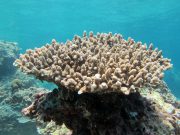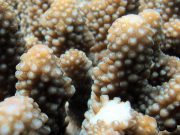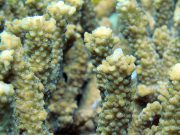Dykning med Staghornskoraller
Lanta Marina Liv | Acroporidae
Familjen Acroporidae, känd som 'staghorn' eller 'grenkoraller', är en familj av hårdkoraller som bildar kolonier med förgrenade strukturer, ungefär som ett träd, ett bord eller en buske, där grenarna eller de fingerliknande utväxterna är täckta av tusentals korallpolyper.
Många arter av staghornkoraller ses dykning från Koh Lanta.
Dessa snabbväxande korallgrenar omges vanligtvis av små korallpolyper, så kallade radialkoraliter, och toppas av en distinkt axialpolyp som normalt är större än radialpolyperna.
Acropora-koraller finns i många olika former och storlekar och kan variera mycket i färg och form, även inom samma art.



Enorma kolonier kan bildas, och många arter är mycket viktiga revbyggare. Färger och kolonibildning kan bero på korallens växtförhållanden, djup, vattnets klarhet, strömmar och så vidare.
Kolonierna kan vara grenade, bordsformade eller i vissa fall överkrustande och finns på alla dykplatser runt Koh Lanta.
Identifiering av staghornskoraller är svårt och kräver antingen noggrann undersökning av koralliterna eller till och med en biokemisk och genetisk analys i extrema fall.
Nya kolonier bildas när grenar bryts av och fästs på nytt i underlaget, vilket kallas asexuell reproduktion. Den sexuella fortplantningen (leken) hos Acropora-koraller sker en eller två gånger om året vid fullmåne, och lekmånaderna varierar beroende på art och plats.
Mer information finns här http://www.coralsoftheworld.org/page/home/
6 arter finns på denna sida:
- Acropora Austera Branching Coral (Acropora austera)
- Acropora Granulosa Table Coral (Acropora granulosa)
- Acropora Hyacinthus Table Coral (Acropora hyacinthus)
- Acropora Humilis Branching Coral (Acropora humilis)
- Acropora Secale Branching Coral (Acropora secale)
- Acropora Korusini Table Coral (Acropora korusini)
Acropora Austera Branching Coral
(Acropora austera)
This species forms colonies of very different shapes, from arborescent (tree-like) to very dense bushes/thickets. Branches vary in length, can be long, disorderly and partially fused. Sub branches are short, tapered and very abundant.

Acropora austera @ Koh Haa
The axial corallites are short, thick tubes with small openings. Radial corallites are sometimes arranged in rows, very close to each other, of different sizes and have thick walls with oblique, round or square openings.
Radial corallites vary from immersed to appressed, making the branches appear ragged.

Acropora austera @ Koh Haa
Acropora Granulosa Table Coral
(Acropora granulosa)
This table-like species in generally uncommon and grows in semi-circular horizontal plates, usually less than 1 m in diameter. The main branches are usually straight and horizontal, with the short secondary branches curving upward and equidistant to each other.

Acropora granulosa @ Hin Bida
Each secondary branch or branchlet is formed by a group of axial corallites and developing axial corallites, or only a single, large axial corallite which is long, think and swollen with a relatively small opening.
The axial corallite tip may be tapered or blunt. The radial corallites are tubular, small and appressed (their wall is directly attached to the branch from which they grow)

Acropora granulosa @ Hin Bida
Acropora Hyacinthus Table Coral
(Acropora hyacinthus)
This species forms wide flat table-shaped colonies and tiered aggregations of small plates with short branches that curve upwards in an orderly way. The central branches are usually fused.

Acropora hyacinthus @ Koh Haa
The axial corallites are tubular, rounded and slightly prominent. The radial corallites form rosettes, with the coralite wall attached to the branch from which it grows. Radial coralites are next to each other, and of the same size.
Acropora Humilis Branching Coral
(Acropora humilis)
This species forms digitate colonies with a broad, encrusting base Branches are thick, finger-like, gradually tapering to large dome-shaped axial corallites. This coral species can be cream, green, purple or blue.

Acropora humilis @ Koh Bida
The radial corallites are of two sizes, the larger are usually tubular, with thick walls and have oblique to nariform openings.
The smaller radial corallites are tubular apressed with a less developed outer wall and nariform opening.

Acropora humilis @ Koh Bida
Acropora Secale Branching Coral
(Acropora secale)
This species forms corymbose bushy colonies with thick tapered branches which are finger-like. Colonies are colourful, usually mixtures of cream, blue, purple, brown and yellow, commonly with purple branch ends and cream corallites.

Acropora secale @ Koh Bida
The axial corallites are tubular, small and have a relatively wide edge. The radial corallites are of mixed sizes, some are long tubes with round opening, others appressed (part of their wall is attached to the branch from which they stem).
The radial corallites are large and conspicuous, and some are quite long. Branches can look ragged or rough.

Acropora secale @ Koh Bida
Acropora Korusini Table Coral
(Acropora korusini)
This species forms corymbose colonies that can form a table-like structure with vertical branches. Branches along the outer edges are more horizontal than those in the center. The colony has a generally disorderly layout.

Acropora korusini @ Koh Bida
The axial corallites are tubular or slightly cone shaped, small and prominent. The radial corallites are lip-like/nariform with a swollen outer wall.
Some radial corallites may be slightly hooked and some may face in different directions. Radial corallites are next to each other and may be a mix of both large and small sizes.

Acropora korusini @ Koh Bida
Dykning med Staghornskoraller runt Koh Lanta
Dykning och Snorkelutflykter
Om du vill ha en chans att se Staghornskoraller på en av våra dagliga högsäsongs dykresor från Koh Lanta, skicka oss ett e-postmeddelande till info@diveandrelax.com.
Följ med på våra dykresor med speedboat under högsäsong till några av Thailands bästa dykplatser och njut av små grupper, korta restider och fokus på personlig service, säkerhet och nöje.
Är du ännu inte certifierad dykare? Lär dig att dyka på Koh Lanta med den 3-dagars SSI Open Water Diver-kursen.
Boka online och spara 10 % på dykresor och dykkurser på Koh Lanta.
Ta Reda på Mer
Guider för Marina Djur och Växter i Indo-Stilla Havet
- Allen, G., Steene, R., Humann, P., DeLoach, N. (2003) Reef Fish Identification, Tropical Pacific. Jacksonville, FL., USA: New World Publications, Inc., ISBN 1-878348-36-1.
- Humann, P., DeLoach, N., (2010) Reef Creature Identification, Tropical Pacific. Jacksonville, FL., USA: New World Publications Inc., ISBN 978-1-878348-44-9
- Debelius, H. (2013) Indian Ocean Reef Guide. Frankfurt, Germany: IKAN - Unterwasserarchiv, ISBN 978-3-939767-52-7.
- Debelius, H. (2004) Nudibranchs and Sea Snails, Indo-Pacific Field Guide. Frankfurt, Germany: IKAN - Unterwasserarchiv, ISBN 3-925919-51-1
- Erhardt, H., Knop, D. (2015) Corals Indo-Pacific Field Guide. Frankfurt, Germany: IKAN - Unterwasserarchiv, ISBN 3-925919-69-4.
- Veron J.E.N., Stafford-Smith M.G., Turak E. and DeVantier L.M. (2016). Corals of the World





